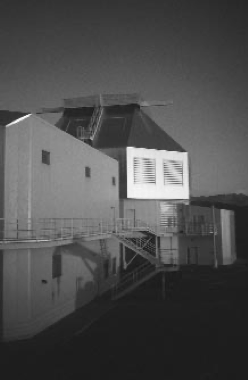Magellan Telescopes
Linking Chile with the Universe

Outside the Magellan Telescope
The center of our galaxy passes directly overhead Las Campanas in Chile. Velvet dark night skies and long stretches of clear weather provide extraordinary opportunities to study astronomical objects not visible from the Northern Hemisphere.
That’s why the twin Magellan Telescopes, an enormous 6.5 meters in diameter, provide a sharp and intimate view of the Magellanic Clouds, satellites of our own Milky Way Galaxy. Harvard professors and students, astronomers from other U.S. universities and their Chilean counterparts are finding this outpost located at an altitude of 8000 feet on the fringe of the Atacama Desert is bringing them closer to understanding our universe.
Astronomers use Magellan for a wide range of programs, from finding new (small) planets in the solar system, through studies of stars, galaxies, and galaxy clusters, all the way up to measuring the properties of the Universe on the largest scales. My own work at Magellan focuses on determining the properties of the mysterious Dark Energy that appears to be making the expansion of the Universe accelerate.
Observations at Magellan by Kris Stanek and my postdoctoral student Tom Matheson helped crack open the mystery of the origin of gamma ray bursts by showing that, after the light from the burst had faded, there was a supernova at the site of a type we recognized. These events probably mark the formation of a black hole at the center of a massive star.
Harvard faculty, postdoctoral and graduate students are frequent visitors to Chile, with about 140 nights of observing time each year, typically in four- or five-night blocks reserved for them. Some undergraduates have also arranged to work at observatories in Chile and we hope to expand this activity. Contacts with Chilean universities are cordial, but not as close as those of Princeton and Columbia, which have joint postdocs who spend time at each institution, but are entitled to apply for the telescope time reserved for Chileans.
Harvard is a 20% partner in the Magellan Telescopes, completed in 2002 at a cost of $67.5 million. Gifts from Harvard alumni provided the resources for Harvard to join the Magellan Project. About 10% of the observing time on this and most other telescopes in Chile, is used by Chilean astronomers, providing them with an extremely valuable resource in return for hosting the observatories.
Harvard is also a member of AURA, the organization that runs the Cerro Tololo Inter-American Observatory in Chile for the NSF, and of AUI, the organization that runs the National Radio Astronomy Observatory, which is building the Atacama Large Millimeter Array high on the altiplano in the extreme north of Chile.
Together with our Magellan partners (MIT, Michigan, Arizona, and the Carnegie Observatories) we are exploring the possibilities for the Giant Magellan Telescope with seven huge mirrors. This would be the world’s largest optical and infrared telescope. We hope that Harvard will continue to have an important role in the development of astronomy in Chile.
Spring 2004, Volume III, Number 3
Robert P. Kirshner is Professor of Astronomy at Harvard University and an Associate Director of the Harvard-Smithsonian Center for Astrophysics. Joining the Harvard Astronomy Department in 1986, he served as Chairman of the department from 1990-1997. He is an author of more than 200 research papers dealing with supernovae, the large-scale distribution of galaxies, and the size and shape of the Universe. He is also the teacher of Science A-35, a core curriculum course for 250 Harvard undergraduates entitled “Matter in the Universe.” The vivid (and slightly hazardous) demonstrations in Science A-35 led to Kirshner’s being featured in Boston Magazine in its October 1998 article on “Nutty Professors”.
Related Articles
The Other 9/11
Like a bolt of lightning that illuminates a darkened landscape, attracting everyone’s attention, the recent commemoration of the 30th anniversary of the military coup of 9-11-1973 has…
Open Schools, Open Minds, Open Societies
Seventeen years of authoritarian rule leave deep scars in the people of a nation. They also leave deep marks in an education system. On a trip to Chile in June 2003 to study the effects of…
Naked in Santiago
On a freezing winter Sunday morning in July 2002, four thousand people euphorically took off their clothes in a downtown Santiago park. Spencer Tunick, the American photographer working…




